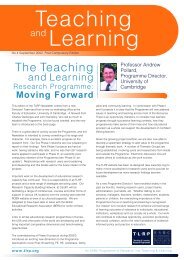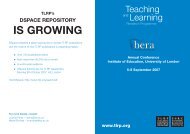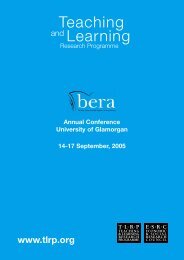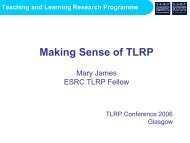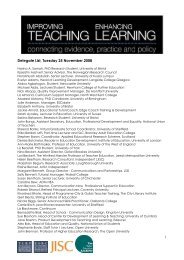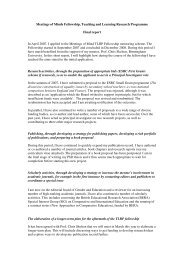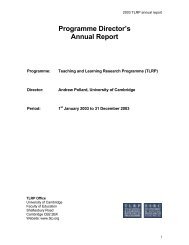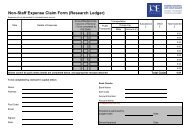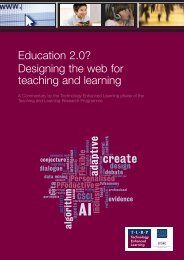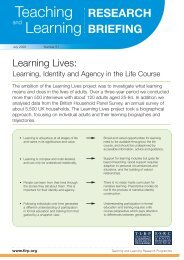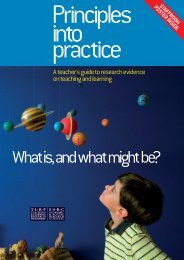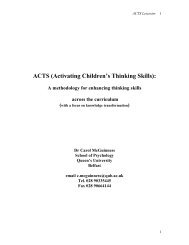Assessment in schools Fit for purpose? - Teaching and Learning ...
Assessment in schools Fit for purpose? - Teaching and Learning ...
Assessment in schools Fit for purpose? - Teaching and Learning ...
Create successful ePaper yourself
Turn your PDF publications into a flip-book with our unique Google optimized e-Paper software.
The most helpful response can often <strong>in</strong>volve steer<strong>in</strong>g a discussion <strong>in</strong> directions that were not envisaged, so<br />
that the orig<strong>in</strong>al lesson plan must be put on hold. Many teachers have said that “I feel I am los<strong>in</strong>g control”, but<br />
some such “loss” may be essential if the teach<strong>in</strong>g is to respond to the needs of the learners. Research evidence<br />
from the TLRP Learn<strong>in</strong>g How to Learn project suggests that what teachers need is not rigid lesson plans but<br />
frameworks of key ideas that will enable them to ma<strong>in</strong>ta<strong>in</strong> the “flow” towards learn<strong>in</strong>g goals whilst adapt<strong>in</strong>g the<br />
lesson to take account of pupils’ ongo<strong>in</strong>g struggles or leaps <strong>for</strong>ward <strong>in</strong> underst<strong>and</strong><strong>in</strong>g.<br />
Research by Paul Black <strong>and</strong> colleagues also shows that summative tests can be used <strong>for</strong>matively if the pupils’<br />
responses are discussed with them to develop an exploration of important aspects that their answers may<br />
reveal. The key difference does not lie <strong>in</strong> the test questions, but <strong>in</strong> the <strong>purpose</strong> <strong>for</strong> which the responses are<br />
<strong>in</strong>terpreted <strong>and</strong> used.<br />
However, frequent summative test<strong>in</strong>g is not, of itself, <strong>for</strong>mative. A teacher may set pupils some questions,<br />
whether <strong>in</strong> a test or <strong>in</strong> rout<strong>in</strong>e written work, <strong>and</strong> <strong>in</strong> the light of their results tell them what they need to do to<br />
reach, <strong>for</strong> example, the next target or level. This is not <strong>for</strong>mative unless the <strong>in</strong>teraction is designed to help pupils<br />
to learn. This crucial po<strong>in</strong>t can be illustrated by a boy’s response to the mark<strong>in</strong>g of his homework. The teacher<br />
had written on the work “use paragraphs”, to which he retorted: “If I’d known how to use paragraphs, I would<br />
have done”. Marks, levels, judgmental comments or the sett<strong>in</strong>g of targets, cannot, on their own, be <strong>for</strong>mative.<br />
Pupils may need help to know how they can improve.<br />
The term “assessment <strong>for</strong> learn<strong>in</strong>g” is often used <strong>in</strong>terchangeably with “<strong>for</strong>mative assessment”. In 1999, the<br />
<strong>Assessment</strong> Re<strong>for</strong>m Group def<strong>in</strong>ed assessment <strong>for</strong> learn<strong>in</strong>g as “the process of seek<strong>in</strong>g <strong>and</strong> <strong>in</strong>terpret<strong>in</strong>g<br />
evidence <strong>for</strong> use by learners <strong>and</strong> their teachers to decide where the learners are <strong>in</strong> their learn<strong>in</strong>g,<br />
where they need to go <strong>and</strong> how best to get there”. ARG also identified ten pr<strong>in</strong>ciples <strong>for</strong> <strong>for</strong>mative<br />
assessment practice, argu<strong>in</strong>g that it should:<br />
1 be part of effective plann<strong>in</strong>g,<br />
2 focus on how pupils learn<br />
3 be central to classroom practice<br />
4 be a key professional skill<br />
5 be sensitive <strong>and</strong> constructive<br />
6 foster motivation<br />
7 promote underst<strong>and</strong><strong>in</strong>g of goals <strong>and</strong> criteria<br />
8 help learners know how to improve<br />
9 develop the capacity <strong>for</strong> self-assessment<br />
10 recognise all educational achievement<br />
What, then, is required if the aim of <strong>for</strong>mative feedback is to help learners<br />
to grow <strong>in</strong> capacity to manage their own learn<strong>in</strong>g, <strong>in</strong> order to progress<br />
effectively <strong>in</strong> develop<strong>in</strong>g capability <strong>in</strong> specific subject doma<strong>in</strong>s? As implied by<br />
the ARG def<strong>in</strong>ition, learn<strong>in</strong>g can be seen as a journey <strong>in</strong> which learners need<br />
to know where they are at present, where they are go<strong>in</strong>g, <strong>and</strong><br />
how to get from the one place to the other.



